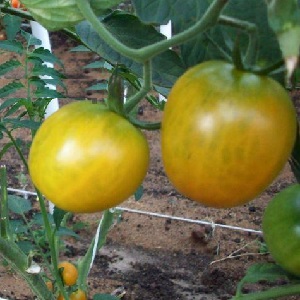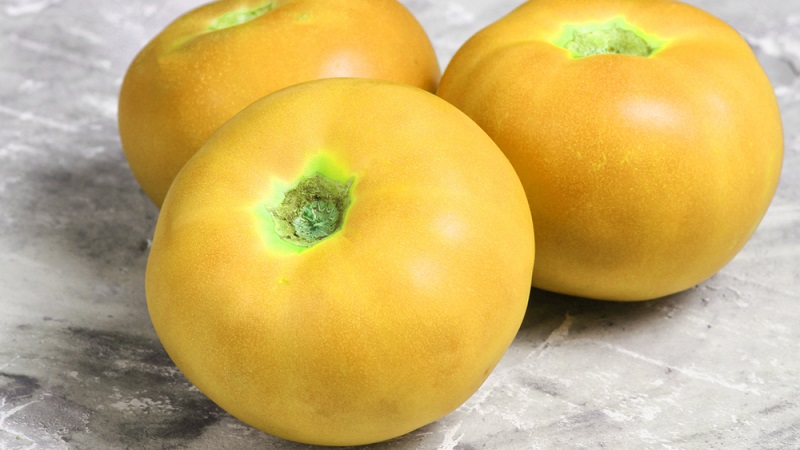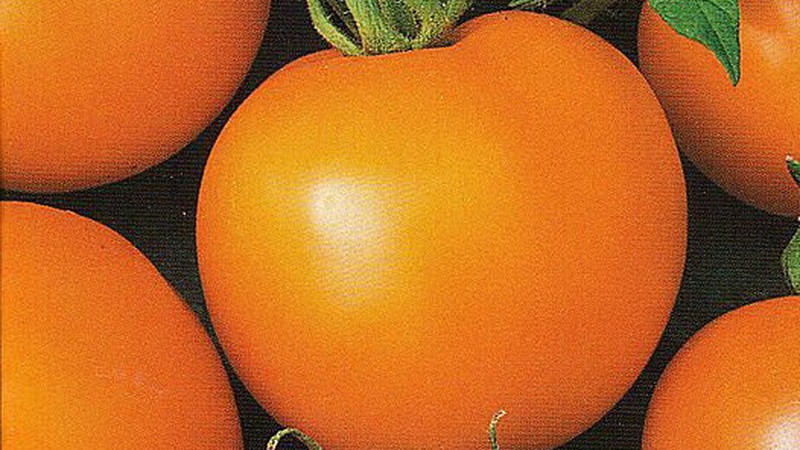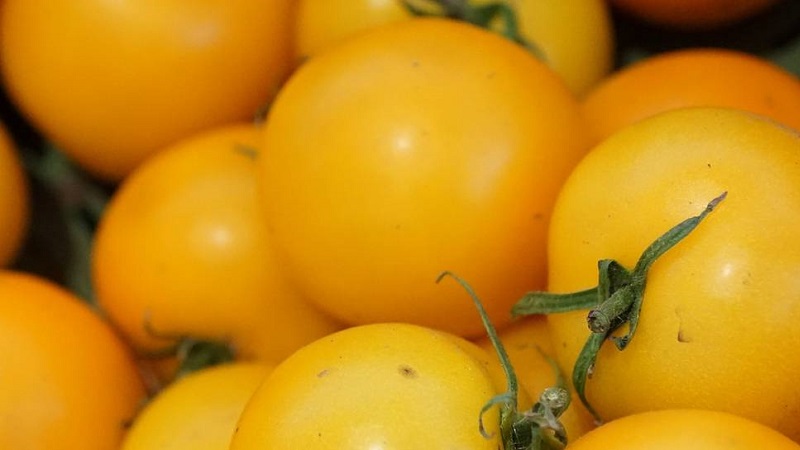The unusual tomato "Giraffe" so named for its tallness
In the winter season, fresh tomatoes are considered a luxury. They are found on store shelves, but at a high price and with dubious taste. Therefore, gardeners began to squeeze more late varieties with high keeping quality on their plots.
Among the varieties for long-term storage, the Giraffe tomato stands out. Its yellow fruits do an excellent job with vitamin deficiency and are able to lie fresh until early spring. How to grow a variety with exceptional keeping quality on your plot, and whether its harvest is worth your attention - read on.
The content of the article
general description
The giraffe is a varietal tomato. He received this name for the height of the bushes, which reaches 2 m. The seeds of the fruits of this tomato are suitable for planting.
Relatively recently, this variety was at the peak of popularity, which is associated with the unusual origin of the Giraffe. When creating it, breeders used the flounder gene. This was done for the sake of increasing the frost resistance of the plant, but the experiment gave an unexpected result - the variety received exceptional keeping quality.
Attention! The Giraffe variety belongs to genetically modified plants. How dangerous GMO tomatoes are is not yet known. Some scientists believe that such products are capable of causing infertility, mutations in offspring, etc. Others claim that GMOs are absolutely safe.

Distinctive features of the variety
The main feature of Giraffe tomatoes is their high keeping quality. The fruits of this variety are stored in boxes all winter, until March 8.
Giraffe fruits are dark yellow. Lighter spots may be present. The pulp is different from the shell and has an orange-pink color.
This shade of berries is provided by the high content of beta-carotene. This substance has a positive effect on visual acuity, condition of the skin and hair, and the immune system. Doctors note the fact that yellow-fruited tomatoes are less likely to cause an allergic reaction than red-fruited ones. They contain fewer purines.
General characteristics
Now the popularity of the tomato Giraffe has subsided somewhat, since the process of its creation causes an ambiguous reaction in people. But fans of this variety still remain, which is explained by its unique characteristics.
Characteristics and description of the variety:
| Parameter | Indicators |
| Bush type | Indeterminate... It reaches a height of 2 m. The stems are strong and powerful. The bushes are covered with an average number of leaves, not spreading and do not form very many stepsons. Leaves are simple, light green, without pubescence, of medium size. The inflorescences are also simple. The first is formed at the level of 7-9 leaves, the next - after 2 leaves. Fruits are formed in clusters of 5-7 pcs. on each. Up to 10 brushes are formed on one bush. |
| Growing method | Tomato is resistant to negative environmental factors. Suitable for greenhouse and outdoor cultivation. |
| Yield | High. 5 kg of berries are harvested from 1 bush per season. From 1 sq. m get about 15 kg of fruit. |
| Fruit | Medium size. The average weight of one berry is 80-100 g. Specimens of 150 g are rarely found. The color of the shell is dark yellow. Light yellow spots are possible. Inside, the fruits are orange-pink, the presence of lighter spots is possible. The shape of the berries is round, sometimes slightly elongated.There is a pronounced ribbing at the base. The pulp is firm, not very juicy, tough. The fruit tastes sweet and sour. Inside each berry there are 3-4 chambers with a lot of seeds. |
| Transportability | The fruit has a dense skin that protects it from damage during transportation. Tomatoes harvested at the stage of technical maturity can be stored in boxes for up to 6 months. |
| Ripening terms | The variety is late ripening. The fruits ripen in mid-August. Fruiting continues for 1.5 months. |
| Disease resistance | It has immunity to viral diseases: tobacco mosaic, brown spot and brown rot. There is no resistance to late blight. |
How to grow seedlings
For seedlings, tomato seeds are sown Giraffe 2 months before planting plants in a permanent place. The lower the temperature in the region, the later the seedlings grow.
Before sowing seeds, gardeners recommend that you familiarize yourself with the lunar calendar indicator. The experience of growing tomatoes shows that plants planted on the correct lunar day grow healthier and give a bountiful harvest.
Planting material processing
 Tomato seeds must be prepared before planting. This will prevent infection of plants in the future, increase their resistance to adverse environmental factors and accelerate the germination of planting material.
Tomato seeds must be prepared before planting. This will prevent infection of plants in the future, increase their resistance to adverse environmental factors and accelerate the germination of planting material.
Before proceeding with the processing of seeds, they are checked for germination, soaking in a salt solution for half an hour (1 tsp of salt is taken in a glass of warm water). Instances that have surfaced are considered tainted. Those that have sunk to the bottom are washed and used for planting.
Next, the seeds are disinfected by soaking in one of the compositions:
- Solution potassium permanganate... For 100 ml of water take 1 g of potassium permanganate. The seeds are soaked for half an hour, then washed with clean water.
- Hydrogen peroxide. The planting material is soaked for a quarter of an hour, after which it is washed.
- Soda solution. In 1 st. water is dissolved 1 tsp. soda. The planting material is soaked for 12 hours.
After that, the seeds are treated with growth stimulants. Use commercially available drugs, such as sodium humate, or homemade products.
Tanks and soil mixtures for growing tomatoes
Seeds are usually sown in wooden boxes or plastic trays. Any wide but not deep container will do.
There are three options for picking seedlings:
- Peat pots. They are considered the most convenient option, since you do not need to extract tomatoes from them when transplanting to a permanent place.
- Plastic pots. They are also convenient to use, as they have ready-made drainage holes.
- Materials at hand - any containers with a volume of 300 ml: cut bottles, disposable cups, etc. It is imperative to make drainage holes.
Peat tablets and special cassettes are used for sowing seeds. Another option is to divide the boxes into separate sections.
Soil for growing tomato seedlings bought in a store or prepared on their own. Most often, gardeners use the following composition options:
- a mixture of peat, humus and black soil in equal proportions;
- a mixture of garden soil and sand in a ratio of 2: 1;
- a mixture of peat and ash.
The soil for tomatoes and containers are disinfected with a strong solution of potassium permanganate or high temperatures.
Seed sowing methods
There are many ways of sowing seeds for seedlings. The list contains the most popular:
- Sowing seeds in a general container. Soil is poured into the boxes so that there is a free space of 3 cm to the edge.It is poured with warm water. The seeds are laid out in rows at a distance of 2-3 cm from each other, sprinkled on top with a centimeter layer of earth. The boxes are covered with foil and put away in a warm place.
- Peat tablets. The tablets are soaked in boiling water, folded into one deep container. When they swell and increase in size, turn over. One seed is planted in each workpiece, deepening by 1 cm.Containers with tablets are covered with foil and placed in a warm place.
- Without land. 2-3 layers of napkins are placed at the bottom of a deep container, moistened with warm water. The seeds are laid out on paper and covered with several more layers of napkins, which are moistened with a spray bottle. The structure is covered with foil and placed in a place with a temperature of 25-26 ºC. After seed germination and the appearance of cotyledonous leaves, the plants are planted in individual pots.

Seedling care
To grow healthy and viable plants, seedlings need regular and proper care. How to do it:
- After sowing seed it is important to maintain optimal soil moisture. When dry, it is watered with warm water from a spray bottle.
- The warmer the room, the faster the seeds will germinate. Sunlight is optional at this stage.
- After the first shoots appear, the film is removed from the boxes. The seedlings are rearranged in a well-lit place. Daylight hours for tomatoes at this stage is 16 hours. If there is not enough sunlight, fluorescent lamps are used.
- Plants in a common box are watered with a pipette or syringe. After the tomatoes are planted in separate containers, a watering can is used to moisten the soil. This is done to prevent liquid from getting on the ground part of the plants. Only warm water is used for irrigation.
- During the growing period, tomatoes are fed 3 times. Complex fertilizers with phosphorus and potassium are used. For one plant, take half the portion indicated in the instructions.
- 2 weeks before picking at a permanent place, the tomatoes begin to harden. To do this, they are taken out onto a balcony or street. Quenching begins at half an hour, the time is gradually increased to 16 hours.
Agrotechnics
Giraffe tomatoes are grown in a greenhouse and in the open field. In the first case, they are planted when the soil reaches a temperature of 14-16 ºC. The soil temperature is measured at a depth of 15 cm.
Reference.Tomatoes are planted in a greenhouse 2 weeks earlier than in open ground.
In the southern regions, tomatoes are grown only outdoors. In the greenhouse, there is a chance that the fruits will not set due to the high temperatures.
Planting seedlings in a permanent place
The plot of the garden where the tomatoes will grow is prepared in the fall. The soil is dug up and cleaned of plant residues. Then fertilizers are applied: cow dung, chicken dung or humus. To reduce the acidity of the soil, dry lime or ash is used.
In the spring, the beds are dug up. All roots that have managed to form are removed. The soil is watered with a solution of chicken manure.
Dig holes in rows, keeping a distance of 60 cm. For 1 sq. m 3 tomatoes are planted. 1 tbsp is poured into each hole. l ash or granular fertilizers.
5 days before the pick, the seedlings are fertilized and fed. Fertilizers containing phosphorus are used.
Place 1 plant in the hole. The deepening is covered with soil and compacted. 1 liter of water is poured under the root.

Tomato care
Tomatoes are tied to a wooden support or trellis. As it grows, the bush is attached to the support with synthetic thread. Natural material cannot be used as it rots.
Giraffe bushes are formed into 2 or 1 stem. In regions with a cool climate, it is better to leave 1 stem, then the tomatoes will have time to ripen.
It is important to remove excess leaves during the formation process. Tomatoes are grown no more than once a week. The procedure is best done on cloudy days.
Water the tomatoes as the soil dries out (2-3 times a week). Use 2-3 liters of liquid per bush. On days of pinching, the soil is not moistened.
After each watering, tomato beds are loosened to prevent soil crust, which interferes with normal air exchange. It is important to clear the weeds from the beds. Weeds slow the growth of tomatoes and promote infections.
Growing features
When growing Giraffe tomatoes, it is important to consider several features of this variety:
- Tomato Giraffe is not afraid of cold snaps, but is susceptible to heat. If the temperature rises above 35 ºC, the pollen will become sterile and no ovaries will form.
- After all the ovaries have formed on the brush, the leaves under it are removed. This speeds up the ripening of the fruit.
- To speed up fruit setting, bushes with formed inflorescences are shaken regularly. This contributes to pollination.

Diseases and pests
Tomato Giraffe is immune to viral infectious agents. His resistance to fungal diseases is lower, and sometimes he is affected late blight.
To avoid contamination of tomatoes, follow the basic rules of prevention:
- Disinfection. Seeds, soil, seedling containers and garden tools are treated with disinfecting solutions.
- Weeding. The beds are regularly cleared of weeds and plant debris.
- Compliance with watering rules. Tomato beds should not dry out, but they should not be waterlogged either. These conditions favor the development of bacteria.
- The right place for the beds. Tomatoes are not planted in the area of the garden where nightshade crops grew last year. Tomato beds are not placed near potatoes.
- Preventive treatment. For the prevention of fungal diseases, the bushes are sprayed with copper sulfate, a solution of potassium permanganate or bordeaux liquid... To protect against insects, plants are treated with soapy water and celandine infusion.
- Preventive examinations. Tomato bushes are inspected every week. Large insects are removed. Sick plants are treated or removed from the beds.
Features of cultivation in open and closed ground
When growing tomatoes in a greenhouse, it is important to avoid stagnant air. Therefore, the room is regularly ventilated by opening the vents.
Before planting tomatoes, the walls of the greenhouse are treated with copper sulfate.
In the open field, the first 10 days after planting, the tomatoes are covered with foil overnight. This prevents them from freezing.

Harvesting and application of the crop
The first fruits of the Giraffe ripen in mid-August. They are collected by the piece, keeping the stalk.
To ensure the maximum keeping quality of the crop, it is better to harvest it at the stage of technical ripeness. The fruits, ready to harvest, are large and have a shiny skin. They ripen beautifully in boxes.
The giraffe is suitable for preservation whole and in pieces. Fresh, not everyone likes it, since it does not have juiciness.
Advantages and disadvantages
Benefits of seeds:
- unique keeping quality;
- immunity to fungal diseases;
- unpretentious care;
- high content of beta-carotene.
Disadvantages of the Giraffe:
- mediocre taste;
- tough pulp;
- bred by genetic engineering;
- need to pinch and tie up.
Farmers reviews
Reviews of gardeners about the Giraffe are contradictory. Not everyone likes the taste and origin of this variety.
Maxim, Moscow: “I have been planting a Giraffe for several years now. I grow in a greenhouse in one stem, I have not encountered any difficulties in care. The variety gives excellent harvest. The fruits are stored all winter. The taste, of course, is not impressive, not much better than the tomatoes that are sold in stores in winter. Therefore, I plant only 2 bushes, just to have fresh tomatoes on the New Year's table. "
Irina, Voronezh: “Giraffe planted this year. The fruits are shiny, yellow and beautiful, as in the photo. Doesn't taste good. They are stored for a really long time. I would continue to grow the variety in order to eat tomatoes in winter, but I found out that it is GMO. I will not plant any more. "
Conclusion
Tomato Giraffe is one of the longest-lasting varieties. Its fruits remain fresh until March 8th. Therefore, despite not the highest taste and origin, it continues to be cultivated by gardeners in our country.